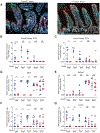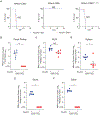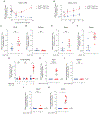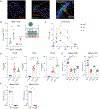Tuft-cell-intrinsic and -extrinsic mediators of norovirus tropism regulate viral immunity
- PMID: 36351394
- PMCID: PMC9662704
- DOI: 10.1016/j.celrep.2022.111593
Tuft-cell-intrinsic and -extrinsic mediators of norovirus tropism regulate viral immunity
Abstract
Murine norovirus (MNoV) is a model for human norovirus and for interrogating mechanisms of viral tropism and persistence. We previously demonstrated that the persistent strain MNoVCR6 infects tuft cells, which are dispensable for the non-persistent strain MNoVCW3. We now show that diverse MNoV strains require tuft cells for chronic enteric infection. We also demonstrate that interferon-λ (IFN-λ) acts directly on tuft cells to cure chronic MNoVCR6 infection and that type I and III IFNs signal together via STAT1 in tuft cells to restrict MNoVCW3 tropism. We then develop an enteroid model and find that MNoVCR6 and MNoVCW3 similarly infect tuft cells with equal IFN susceptibility, suggesting that IFN derived from non-epithelial cells signals on tuft cells in trans to restrict MNoVCW3 tropism. Thus, tuft cell tropism enables MNoV persistence and is determined by tuft cell-intrinsic factors (viral receptor expression) and -extrinsic factors (immunomodulatory signaling by non-epithelial cells).
Keywords: CP: Immunology; CP: Microbiology; immune evasion; interferon; mucosal immunity; norovirus; tuft cells; viral persistence; viral tropism.
Copyright © 2022 The Authors. Published by Elsevier Inc. All rights reserved.
Conflict of interest statement
Declaration of interests The authors declare no competing interests.
Figures






Similar articles
-
CD300lf Conditional Knockout Mouse Reveals Strain-Specific Cellular Tropism of Murine Norovirus.J Virol. 2021 Jan 13;95(3):e01652-20. doi: 10.1128/JVI.01652-20. Print 2021 Jan 13. J Virol. 2021. PMID: 33177207 Free PMC article.
-
Norovirus Cell Tropism Is Determined by Combinatorial Action of a Viral Non-structural Protein and Host Cytokine.Cell Host Microbe. 2017 Oct 11;22(4):449-459.e4. doi: 10.1016/j.chom.2017.08.021. Epub 2017 Sep 28. Cell Host Microbe. 2017. PMID: 28966054 Free PMC article.
-
IFN-λ derived from nonsusceptible enterocytes acts on tuft cells to limit persistent norovirus.Sci Adv. 2023 Sep 15;9(37):eadi2562. doi: 10.1126/sciadv.adi2562. Epub 2023 Sep 13. Sci Adv. 2023. PMID: 37703370 Free PMC article.
-
The Role of Interferon in Persistent Viral Infection: Insights from Murine Norovirus.Trends Microbiol. 2018 Jun;26(6):510-524. doi: 10.1016/j.tim.2017.10.010. Epub 2017 Nov 17. Trends Microbiol. 2018. PMID: 29157967 Free PMC article. Review.
-
Tuft cells are key mediators of interkingdom interactions at mucosal barrier surfaces.PLoS Pathog. 2022 Mar 10;18(3):e1010318. doi: 10.1371/journal.ppat.1010318. eCollection 2022 Mar. PLoS Pathog. 2022. PMID: 35271673 Free PMC article. Review.
Cited by
-
Interferons and tuft cell numbers are bottlenecks for persistent murine norovirus infection.PLoS Pathog. 2024 May 3;20(5):e1011961. doi: 10.1371/journal.ppat.1011961. eCollection 2024 May. PLoS Pathog. 2024. PMID: 38701091 Free PMC article.
-
Amino acid substitutions in norovirus VP1 dictate host dissemination via variations in cellular attachment.J Virol. 2023 Dec 21;97(12):e0171923. doi: 10.1128/jvi.01719-23. Epub 2023 Nov 30. J Virol. 2023. PMID: 38032199 Free PMC article.
-
Murine norovirus mutants adapted to replicate in human cells reveal a post-entry restriction.bioRxiv [Preprint]. 2024 Jan 11:2024.01.11.575274. doi: 10.1101/2024.01.11.575274. bioRxiv. 2024. Update in: J Virol. 2024 May 14;98(5):e0004724. doi: 10.1128/jvi.00047-24. PMID: 38260699 Free PMC article. Updated. Preprint.
-
Membrane asymmetry facilitates murine norovirus entry and persistent enteric infection.bioRxiv [Preprint]. 2024 Nov 7:2024.11.06.622376. doi: 10.1101/2024.11.06.622376. bioRxiv. 2024. Update in: PLoS Biol. 2025 Apr 17;23(4):e3003147. doi: 10.1371/journal.pbio.3003147. PMID: 39574648 Free PMC article. Updated. Preprint.
-
Norovirus co-opts NINJ1 for selective protein secretion.Sci Adv. 2025 Feb 28;11(9):eadu7985. doi: 10.1126/sciadv.adu7985. Epub 2025 Feb 28. Sci Adv. 2025. PMID: 40020060 Free PMC article.
References
Publication types
MeSH terms
Grants and funding
LinkOut - more resources
Full Text Sources
Medical
Molecular Biology Databases
Research Materials
Miscellaneous

